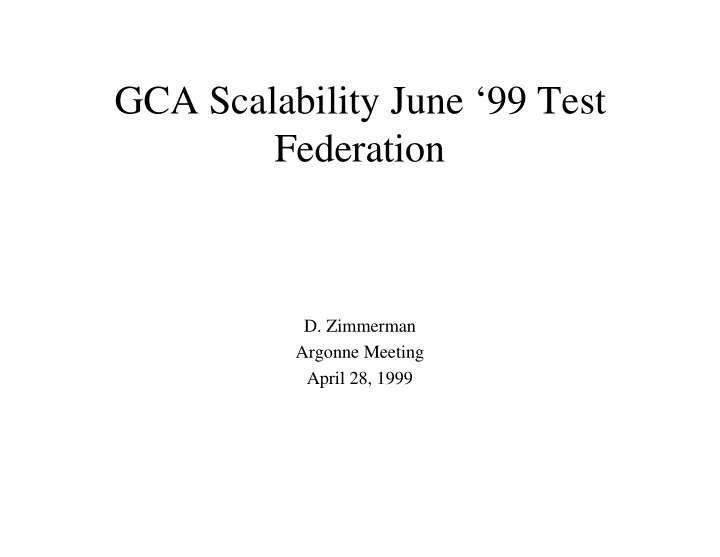

GCA Scalability June ‘99 Test Federation D. Zimmerman Argonne Meeting April 28, 1999
Requirements for the Scalability test Event Store • >=10 million events. • Multiple components for each event, distributed across files. • More complicated distribution of event components in files. “Multiple Bundle Overlap” – E.g. The number of events stored in each component file varies from component to component. • Several hundred Gigabyte of data in HPSS. • Event model which allows user to navigate to at least one component from the event header/ • Tag information for each event (EvID, Bundle, Queryable tag info). Need 25 to 50 components
Proposed Event Store • LBL-HPSS or BNL-HPSS • Root based with some “RAW-format” (unreadable) components • No permanently disk resident components • Includes event components which are non-navigable (large, unreadable files as part of each events fundamental bundle). Similar to RAW data. • Tags consist principally of random numbers, tagrand and FileIDs. • How many tags are required for tests? Do we need actual calculated tags for the events? – If tagdb consists of: �����������������������������������������������������������
Simulated Root Event The Event data member fTracks is a pointer to a TClonesArray. Event and Track classes // It is an array of a variable number of tracks per event. // Each element of the array is an object of class Track with the members: The Event class is a naive/simple // private: example of an event structure. // Float_t fPx; //X component of the momentum // Float_t fPy; //Y component of the momentum public: // Float_t fPz; //Z component of the momentum/ Int_t fNtrack; / Float_t fRandom; //A random track quantity Int_t fNseg; // Float_t fMass2; //The mass square of this particle Int_t fNvertex; // Float_t fBx; //X intercept at the vertex UInt_t fFlag; // Float_t fBy; //Y intercept at the vertex Float_t fTemperature; // Float_t fMeanCharge; //Mean charge deposition of all hits of this track EventHeader fEvtHdr; // Float_t fXfirst; //X coordinate of the first point TClonesArray *fTracks; // Float_t fXlast; //X coordinate of the last point // Float_t fYfirst; //Y coordinate of the first point // Float_t fYlast; //Y coordinate of the last point // Float_t fZfirst; //Z coordinate of the first point // Float_t fZlast; //Z coordinate of the last point // Float_t fCharge; //Charge of this track // Int_t fNpoint; //Number of points for this track // Short_t fValid; //Validity criterion
Proposed Event Store Pt.2 • 1000 Runs (files) of 10000 events each – 3 Root (branches) files per event – Individual Root event size of 50Kb – 3 Root files per run whose total size = 1.5 GB – Two 250 Mbyte “RAW” file per run • 10^7 events in the store • 1000 files (each event consists of 5 files) • Total volume ~2TB
Event characteristics • Only Root event components (branches) are navigable • Complex File Bundles – More realistic to predefine the relative size of the components for an event and “fill” files (fixed to 1 gig) with events during event creation • eg. 200 events in RAW -> 2000 events in Trks. – Another possible multiple bundle overlap: • The association of an event with a RAW file is made stochastically • Where the RAW files associated with a given Event are selected from the set of RAW files via: – 30% chance of ThisRAWFileNumber-1 – 50% chance of ThisRAWFileNumber – 20% chance of ThisRAWFileNumber+1
Recommend
More recommend